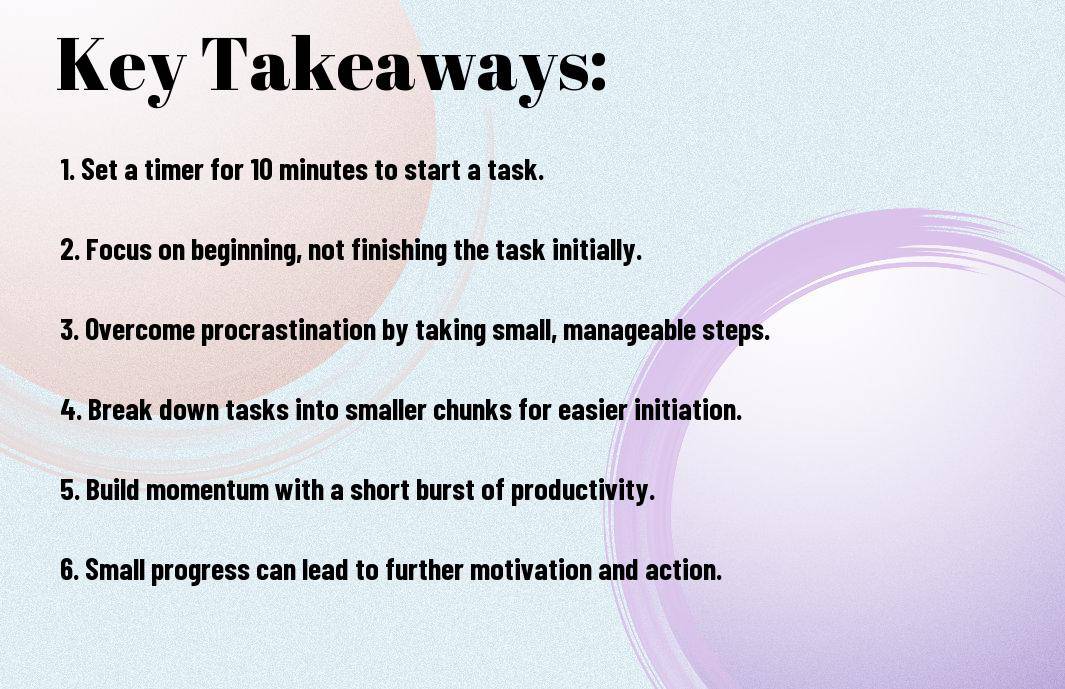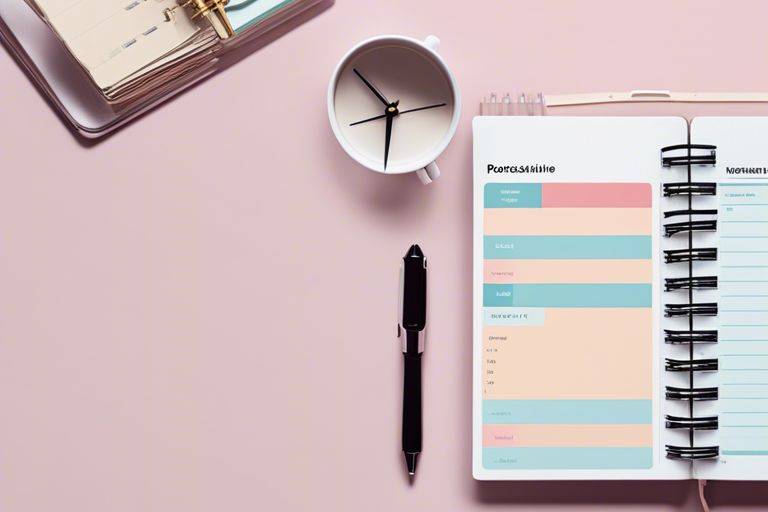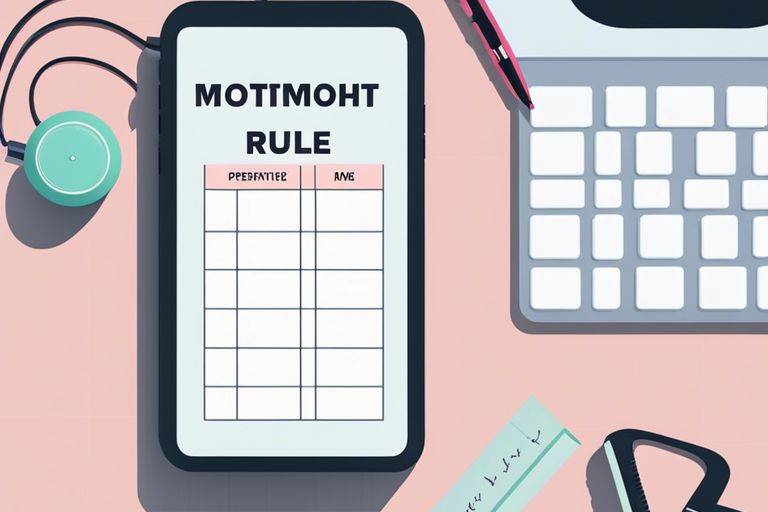With numerous distractions and tasks vying for our attention, procrastination can sneak up on even the most disciplined individuals. The 10-Minute Rule is a simple yet effective technique to combat this common tendency. By committing to work on a task for just 10 minutes at a time, you can overcome the initial hurdle of getting started and gain momentum towards greater productivity.
Key Takeaways:
- Procrastination Solution: The 10-Minute Rule is a method that can help overcome procrastination by getting started on a task for just 10 minutes.
- Small Steps: Breaking down tasks into smaller chunks can make them less overwhelming and more manageable.
- Progress: Taking action, even for a short amount of time, can lead to momentum and further productivity.
- Builds Momentum: Starting small can help build momentum and motivation to continue working on the task.
- Eliminates Excuses: By committing to just 10 minutes, excuses like “I don’t have time” can be eliminated.
- Develops Consistency: Consistently working on tasks for 10 minutes can lead to the development of a habit of productivity.
- Increases Focus: Focusing on a task for a short period can help improve concentration and reduce distractions.

The 10-Minute Rule – A Method to Overcome Procrastination by Starting Small
Origin of Rule
Even the most disciplined individuals can struggle with procrastination at times. This is where the 10-Minute Rule can be a game-changer. The concept of the 10-Minute Rule is simple but powerful – if a task feels overwhelming, commit to working on it for just 10 minutes.
Rule Explanation
Rule: The idea behind the 10-Minute Rule is to overcome the initial resistance to starting a task by making it seem more manageable. Once you start, you’ll often find that it’s not as daunting as you imagined, and you may even end up working on it for longer than 10 minutes.
The 10-Minute Rule is effective because it leverages the psychological principle of momentum. Getting started is often the hardest part of any task, and once you gain momentum, it becomes easier to keep going. So, remember, the next time you’re putting off a task, give the 10-Minute Rule a try and watch how it can help you overcome procrastination and boost your productivity.

Set Achievable Goals
There’s a common misconception that setting big, audacious goals is the key to success. While it’s important to have long-term aspirations, sometimes the most effective way to overcome procrastination is by setting achievable goals.
Small Task Focus
Assuming you have a daunting project ahead of you, break it down into smaller tasks that you can accomplish in ten minutes or less. By focusing on small tasks, you can ease yourself into the project without feeling overwhelmed. Whether it’s replying to a few emails, making a quick phone call, or researching a specific topic, these small wins can build momentum and propel you forward.
Incremental Progress
An incremental approach to work involves making steady, gradual progress towards a larger goal. Instead of trying to tackle everything at once, break it down into manageable chunks and work on them consistently. By allocating just ten minutes a day to a specific task, you can make significant headway over time.
With the 10-Minute Rule, you can shift your focus from the overwhelming scale of a project to the tangible progress you can achieve in a short amount of time. This method encourages consistency and helps you stay motivated by celebrating the small victories along the way.
Overcome Initial Resistance
Despite our best intentions, starting a new task or project can be daunting. It’s natural to feel resistance when faced with a big challenge or a significant goal. However, overcoming this initial resistance is crucial to breaking the cycle of procrastination.
Break Procrastination Cycle
One effective way to break the cycle of procrastination is to apply the 10-Minute Rule. Instead of overwhelming yourself with the entire project, commit to working on it for just 10 minutes. This small time frame is manageable and helps to alleviate the overwhelming feeling that often leads to procrastination. Once you get started, you may find that it’s easier to continue working beyond the initial 10 minutes.
Quick Start Advantage
Now, the Quick Start Advantage comes into play. By taking that first step, even if it’s just for 10 minutes, you are more likely to gain momentum and build a sense of accomplishment. This can motivate you to keep going and make progress on your goal. Research suggests that starting a task quickly after setting a goal increases the likelihood of successfully completing it.
Start small, but start now. By breaking down your tasks into smaller, more manageable chunks and applying the 10-Minute Rule, you can overcome the initial resistance that often leads to procrastination. Be mindful of, the most important step is the first one. Take that step now and see how it can make a significant difference in your productivity and motivation.
Build Consistent Habits
Daily Routine Importance
Many successful individuals attribute their achievements to the power of consistent habits. When you have a daily routine in place, it sets the foundation for productivity and success. By following a structured routine, you eliminate the need for decision-making and willpower, which can often lead to procrastination.
Now, imagine starting your day with a clear plan of action and specific tasks to accomplish. This not only helps in prioritizing important tasks but also creates a sense of accomplishment as you tick off tasks from your list. Consistency in your daily routine is key to forming lasting habits that will propel you towards your goals.
Habit Formation Tips
- Start Small: Begin by incorporating tiny, achievable habits into your daily routine. This could be as simple as meditating for 5 minutes or reading a few pages of a book every day.
- Be Specific: Clearly define the habit you want to form and the time you will dedicate to it each day. Setting a specific time and place for the habit makes it easier to stick to.
- Reward Yourself: Celebrate your small wins to reinforce the habit loop. Whether it’s treating yourself to a cup of coffee or taking a short break, rewards can motivate you to continue the habit.
Daily consistency is crucial in habit formation. When you repeat a behavior daily, it becomes ingrained in your routine, making it easier to maintain in the long run. This consistency rewires your brain and creates neural pathways that support the habit.
It is necessary to understand that forming habits takes time and effort. While it may be tempting to try and adopt multiple habits at once, focusing on one habit at a time increases the likelihood of success. Keep in mind, building consistent habits is a gradual process, and patience and commitment are key.
Use a Timer
All successful implementations of the 10-Minute Rule rely on the use of a timer. Setting a timer helps create a sense of urgency and can prevent distractions from creeping in during the allotted time frame. Whether you prefer a traditional kitchen timer, a digital timer on your phone, or an online timer extension for your browser, the key is to choose a tool that works best for you and can keep you focused.
Timer Selection
There’s a vast array of timers available, so it’s necessary to find one that suits your needs. Some timers offer customization options such as setting intervals, alarms, and even motivational quotes to keep you on track. Select a timer that is easy to use and provides you with the features that will help you stay disciplined and productive.
Timeboxing Technique
There’s a popular time management technique called the timeboxing technique that can be effectively used in conjunction with the 10-Minute Rule. The timeboxing technique involves breaking down your tasks into smaller, manageable time slots. Set a specific amount of time to work on a task, and when the timer goes off, take a short break before starting the next timebox. This method can increase productivity by enhancing focus and preventing burnout.
Timeboxing with a timer ensures that you dedicate uninterrupted time to your tasks, helping you make significant progress without feeling overwhelmed.
Tackle Unpleasant Tasks
For many of us, the tasks we tend to procrastinate on are the ones we find unpleasant or daunting. Whether it’s a difficult conversation, a tedious project, or a chore we don’t enjoy, these tasks often get pushed to the wayside. However, using the 10-Minute Rule can help break through this barrier and tackle these unpleasant tasks head-on.
Easing into Discomfort
Discomfort is a natural reaction to facing unpleasant tasks. To overcome this initial resistance, start by committing to working on the task for just 10 minutes. By setting a small, manageable goal, you can ease into the discomfort gradually. Oftentimes, you’ll find that once you get started, it’s not as bad as you imagined, and you may even find the motivation to continue beyond the initial 10 minutes.
Reward System Implementation
An effective way to further motivate yourself to tackle unpleasant tasks is by implementing a reward system. Set up small rewards for yourself for completing each step of the task or for working on it for a certain amount of time. This could be a break to enjoy your favorite snack, a short walk outside, or some time to indulge in a hobby you enjoy. By associating a positive reward with the completion of unpleasant tasks, you can begin to reframe your mindset and see them as opportunities for self-improvement and personal growth.
You can certainly customize your reward system to suit your preferences and needs. Just remember to keep the rewards reasonable and appropriate to ensure you stay motivated and focused on completing the task at hand.

Boost Motivation
Keep your motivation levels high by setting small goals that you can easily achieve. This will help you build momentum and stay focused on your tasks. By breaking down your goals into smaller chunks, you can avoid feeling overwhelmed and increase your chances of success. Bear in mind, the key is to start small and gradually work your way up.
Incremental Achievement Recognition
Achievement Celebrate your progress no matter how small. Recognizing your achievements, no matter how minor, will help boost your motivation and keep you on track. Whether it’s completing a task ahead of schedule or staying focused for a set period of time, take the time to acknowledge your accomplishments. This positive reinforcement will fuel your motivation and drive you to tackle the next task on your list.
Positive Reinforcement
Incremental Positive reinforcement plays a crucial role in boosting motivation. It involves rewarding yourself for completing tasks or making progress towards your goals. This can be as simple as giving yourself a small treat or taking a short break. By associating a positive outcome with your efforts, you are more likely to stay motivated and continue working towards your objectives.
Boost your motivation by incorporating positive reinforcement strategies into your daily routine. This can help you stay focused, productive, and on track to achieve your goals. Bear in mind, small rewards can go a long way in keeping your motivation levels high and ensuring that you stay committed to overcoming procrastination.
Address Perfectionism
Not addressing perfectionism can be a major roadblock in overcoming procrastination. When we strive for perfection, we often set unrealistic standards for ourselves, which can lead to anxiety, fear of failure, and ultimately, procrastination.
Overcome Perfectionist Hurdles
One way to tackle perfectionism is to shift your focus from the end result to the process itself. Instead of aiming for perfection in every task, strive for progress and improvement. Understand that it’s okay to make mistakes and that failure is a natural part of the learning process.
Imperfect Action Emphasis
There’s power in taking imperfect action. By embracing imperfection and focusing on taking small, consistent steps towards your goals, you can overcome the paralyzing effect of perfectionism. Remember that progress is more important than perfection, and each small step you take brings you closer to your objectives.
Perfectionism can hinder your productivity and creativity by creating unnecessary pressure and fear of failure. By recognizing the importance of progress over perfection and embracing imperfect action, you can effectively combat procrastination and move towards achieving your goals.

Manage Distractions
Distraction Identification
Now, the first step in managing distractions is to identify what exactly is diverting your attention from the task at hand. This could be anything from the ping of incoming emails, social media notifications, or even the allure of a cluttered workspace. Take a moment to recognize these distractions and acknowledge their impact on your productivity.
Control Environment
You have the power to control your environment and minimize distractions that prevent you from getting started on your tasks. Create a designated workspace that is organized and free from unnecessary items that could easily lead you astray. Choose a quiet area away from high-traffic zones to help maintain focus and concentration.
Identification
It is crucial to differentiate between distractions that can be easily eliminated and those that require more effort to overcome. By identifying the most common distractions that frequently derail your focus, you can take proactive steps to counteract them and stay on track with your tasks.
Scale Up Gradually
Longer Sessions
An imperative aspect of the 10-Minute Rule is the idea of starting small and gradually increasing the time spent on a task. Pertaining to overcoming procrastination, this method can be highly effective. Starting with just 10 minutes of focused work may seem manageable and can help alleviate the overwhelming feeling that often leads to avoidance. Once you’ve mastered the art of staying focused for 10 minutes, you can gradually scale up the duration of your work sessions.
Continuous Improvement
Clearly, the key to success with the 10-Minute Rule lies in continuous improvement. After you have become comfortable working on a task for a certain period, challenge yourself to increase the time spent gradually. This approach will not only help you build endurance and focus but also prevent burnout that can occur when trying to tackle a task for an extended period without breaks.
Longer work sessions can be beneficial in boosting productivity and helping you accomplish more in less time. By incrementally increasing the duration of your focused work sessions, you can train yourself to stay on track and build momentum towards your goals. Be mindful of, progress is key, and every small step counts in your journey towards overcoming procrastination.
Conclusion
On the whole, the 10-Minute Rule is a valuable method that can help individuals overcome procrastination by breaking down tasks into manageable chunks and starting with just 10 minutes. This approach helps to reduce the intimidation often associated with larger tasks, making it easier to get started and build momentum towards completion. By committing to just 10 minutes, people can overcome the initial resistance that often leads to procrastination and create a sense of accomplishment that propels them forward.
For more in-depth insights into this effective strategy, check out The 10-minute rule: a deft trick to beat procrastination.
FAQ
Q: What is the 10-Minute Rule?
A: The 10-Minute Rule is a method to overcome procrastination by committing to work on a task for just 10 minutes. It helps you overcome the initial resistance and build momentum towards completing the task.
Q: How does the 10-Minute Rule help in overcoming procrastination?
A: By breaking the task into a small, manageable chunk of time (10 minutes), the 10-Minute Rule makes it less overwhelming and easier to get started. Once you begin, you often find it easier to continue working beyond the initial 10 minutes.
Q: Can the 10-Minute Rule be applied to any task?
A: Yes, the 10-Minute Rule can be applied to any task, whether it’s work-related, personal, or household chores. It is particularly effective for tasks that you have been putting off due to procrastination.
Q: How can I implement the 10-Minute Rule in my daily routine?
A: To implement the 10-Minute Rule, choose a task that you’ve been procrastinating on, set a timer for 10 minutes, and commit to working on the task without any distractions during that time. Once the 10 minutes are up, decide if you want to continue or take a break.
Q: What are the benefits of using the 10-Minute Rule?
A: Using the 10-Minute Rule helps you overcome the initial inertia of getting started, builds momentum, increases productivity, and reduces procrastination. It also helps in developing a habit of consistent work on tasks.
Q: Are there any tips for maximizing the effectiveness of the 10-Minute Rule?
A: To maximize the effectiveness of the 10-Minute Rule, eliminate distractions during the 10-minute work session, focus on one task at a time, and celebrate your small wins after completing each 10-minute session. Additionally, try to schedule multiple 10-minute sessions for larger tasks.
Q: How can I stay motivated to continue working after the initial 10 minutes are up?
A: To stay motivated after the initial 10 minutes, remind yourself of the progress you’ve already made, break down the task into smaller subtasks, set mini-goals for each 10-minute session, and visualize the feeling of accomplishment you’ll have once the task is complete.
Dive Deeper: Further Explorations for Your Journey
Eat That Frog – Brian Tracy’s Approach to Tackling the Most Challenging Task First
Learning to Say No – The Importance of Prioritizing Tasks and Commitments
SMART Goals – George T. Doran’s Method for Setting Clear and Achievable Goals
The 2 Minute Rule – David Allen’s (popularized) Trick to Overcome Procrastination and Start Tasks
The Science of Concentration in The Art of Focus



